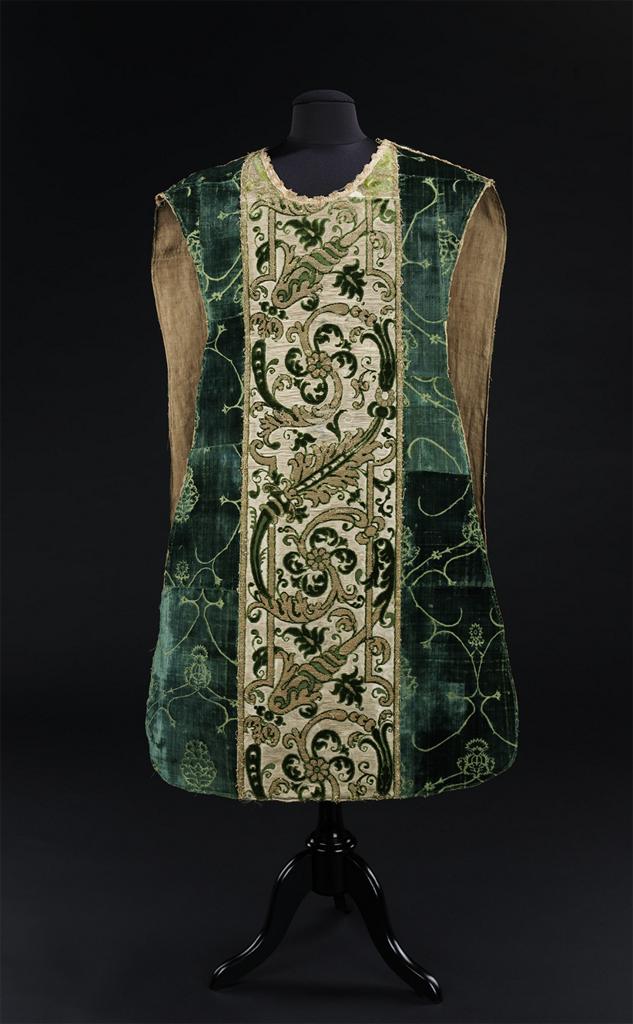Real Italian Renaissance Fashion
The Metropolitan Museum of Art’s annual gala held this past weekend attracted quite a bit of outrage and attention for various haute couture interpretations of the theme ““Heavenly Bodies: Fashion and the Catholic Imagination.” Much was made of the influence of painting upon the designs. However, the original garments made for Roman Catholic clerics during the 15th Century, for example, are extraordinarily imaginative and beautiful works of art, which take us to the heart of the Italian Renaissance. However, like some other short-lived phenomena of Italian Renaissance decorative arts, such as istoriato maiolica or elaborate Cardinals’ seals, they flourished in their purest form only for a limited period. By the mid-16th Century, facing down the Reformation and the rise of Paris as the center of fashion, elaborate clerical wear must already have begun to be regarded as rather old-fashioned.
The textile used in this Venetian chasuble is iconic of the early Renaissance period and highly valued; it is this type of textile that is often seen in religious paintings of the time. The complex and expensive weave structure incorporates pile-on-pile weaving, as well as gold metallic loops within the velvet that add extra glitter and shading. The three-dimensional surface is achieved through the use of different lengths of pile. The figures have been identified as a youthful St. John the Evangelist, holding the cup of poison that did not harm him; St. Andrew, with the book and X-shaped cross with which he is associated; a bearded St. Paul, holding a book and a sword; St. Thomas, holding a book and a carpenter’s angle; and, possibly, St. Philip, holding a book and a staff with a red cross on one end.
The textile used in this green chasuble from Genoa is a beautiful example of elaborate weaving. Here the use of cut and uncut velvet is used to delineate the interior layers of the flowers, which gives them a rich and dimensional appearance. The use of metallic bouclé to provide an additional level of patterning also shows a high level of weaving acumen. The curvilinear pattern known as ferronerieis used here on the main fabric of the chasuble. Ferroneriewas prevalent in textile design during the Renaissance and reflected the ornate ironwork of the period.
In the Middle Ages and in the Renaissance period, Italian fabrics were famous; the entire fashion world in Europe would wear it. One of the most important cities for the production of fabrics was Florence, a place where fine woolen cloth and sumptuous silk drapery was being created. Florentine velvets were created with silk, gold or silver and they truly were a luxury item; no wonder that they were used for the wardrobes of the rich, nobles, kings, queens, and they were represented in so many paintings of the time. Giuseppe Lisio (1870-1943), drawing on this tradition which by the early 20th Century was in severe decline decided to go into business by himself and create a laboratory of silk fabrics in Florence, inspired by the Renaissance works of art. He opened a shop on Via dei Fossi in 1906, thus preserving techniques that were fated to be forgotten. Lisio decided to also open other shops in Rome and Milan. In 1971 the Arte della Seta Lisio Foundation was created, and continues on the ancient techniques of weaving through courses, conferences, and publications.
Reference: Carlo Marco Belfanti. “Renaissance and ‘Made in Italy’: Marketing Italian Fashion Through History.” Journal of Modern Italian Studies, 01 January 2015, Vol.20(1), p.53-66.
Unknown maker, Venetian Chausible (Men’s Ecclesiastical Garment), c. 1550. Silk, metallic, linen; Unknown maker, Genovese Chausible, c. 1575. Silk, metallic. Both, Brooklyn Museum Costume Collection at the Metropolitan Museum of Art, Gift of the Brooklyn Museum, 2009; Gift of the Rembrandt Club; Photographed by Lolly Koon.
Entrance ticket, G. Lisio Reproductions. Brocarts Anciens. Manufacture Forentine. Florence. Rue de Fossi 17, telefono 24-30 [G. Lisio Reproduction of ancient brocades, Florentine factory, Via dei Fossi 17]. “22 May, 1914. Entrance Ticket to House in which Dante was Born.” [ink inscription handwritten by George Watson Cole]; The Lisio Foundation, Trinity College, Watkinson Library (Hartford, Connecticut, USA), Box 14.25-15.
Further Reading: Eugenia Paulicelli. Fashion Under Fascism: Beyond the Black Shirt. New York: Berg, 2004.
Marika Leino. Fashion, Devotion and Contemplation. The Status and Functions of Italian Renaissance Plaquettes. Oxford: Peter Lang, 2013.
Posted by Jean Marie Carey






